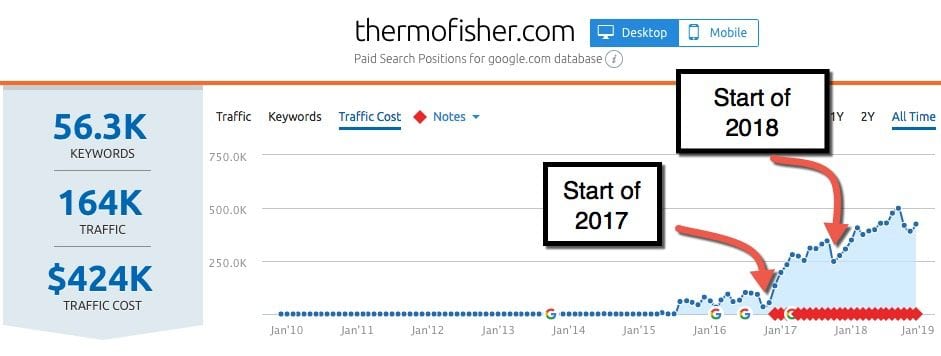Business Management, Conversion Optimization, Digital Strategy, SEO & Content Marketing, Web Development, Website Design & UX
11 Minutes
5 Lessons I Learned from Working 24/7 with the Top Life Science Companies in 2018
Last year, we released a blog article titled 5 Lessons I Learned from Working 24/7 With the Top Life Science Companies in 2017.
This blog article was by far the most popular one we have ever posted.
I think the reason why it resonated with so many life science marketers is because it was a bit of a wake-up call in an industry that is generally late to adopt modern marketing.
For many years, digital marketing in the life science industry has always taken a back seat to other marketing efforts. Five years ago, you could still operate profitably from reputation, previous relationships, and trade shows, even if your life science company didn’t have a strong digital marketing presence.
But things have changed in the last few years, and adaptive life science companies have taken advantage of new sources of revenue through digital channels.
Over the last year, we have learned even more about digital marketing in the life science marketing space, and we are going to share some of the trends we saw in 2018. Hopefully, you can incorporate some of this knowledge into your marketing plans for 2019!.
Lesson 1: The Big Guys Are Doubling Down AdWords (Up 200% from 2017)
In 2017, we saw Thermo quadruple their ad spending on AdWords. In 2018, it was closer to doubling their ad spending. (So that’s a total of 8x as much spending since 2016.)
According to SEMRush.com, Thermo has slowly increased its budget on AdWords, month over month. They maxed out at about $500,000/mo (or $6,000,000/year).
For 2017, they averaged approximately $250,000/mo, so they have doubled their spending on AdWords

The graph above shows how spending has steadily increased since mid-2015.
The graph below gives us some insight into why Thermo is spending more on AdWords.

There are two primary reasons why Thermo increased its AdWords budget:
1) More Keywords
In 2017, Thermo was bidding on approximately 30,000 keywords. In 2018, the average is approximately 50,000 keywords.
So why is Thermo bidding on more keywords in 2018?
When you have an ROI on your ad campaigns, you scale. And you can scale horizontally by adding new keywords.
My guess is they started with their top 30% of revenue-producing products. Then after they started making money on those products, they started making new campaigns to get the rest of their products advertised on Google AdWords.
I’d expect them to keep bidding on more keywords, and eventually level off after the majority of their catalog is being advertised.
2) More Competition
We can see from the graph above that even though Thermo’s spending is up, its average position has fallen on many keywords.
But how could this be happening?
The answer is pretty simple:
More competition drives up the cost per click, which means Thermo can’t afford first-position placement across every single product category.
In 2018, more life science companies were gaining market share for their ideal search terms.
I expect this trend to continue. The truth of the matter is that any small to midsize life science company can beat Thermo in AdWords by writing more specific ads.
If Thermo is bidding on 50,000 KWs, they are likely managing 150,000 ads (three ads per ad group.) It’s simply not possible to give each product the individual attention it needs.
While Thermo will sometimes beat you in branding alone, you can win by speaking to your audience more effectively.
The bottom line: If your website is halfway decent, you can win with AdWords, and almost every company we work with is profiting from AdWords.

Lesson 2: Protect Your Branded Search Terms
Since more companies are flocking to AdWords to fight for search terms that are relevant to their products, the need to protect your branded search is now much more important.
Here at Supreme, we audit approximately 50 AdWords accounts per year, and we know a lot of companies don’t protect their branded search terms.
I know what you’re probably thinking…
“If people are already searching for my products/company, why do I need to pay for the advertising space?”
That’s a great question.
In uncompetitive markets, branded ads are less important, but let’s do a quick exercise to prove the value of a branded search.
But before we get started, I recommend you brace for impact, as the results may scare you a bit.

After you’ve braced for impact, follow these steps:
- Go to google.com.
- Type in “Buy *Insert your company name* *Insert your non-branded product*”.
- Click search.
Here are some examples:
“Buy Alomone Antibodies”

“Creative Diagnostics ELISA Kits”

“Buy Biowest Cell Culture Media”

So what exactly is happening here? Are other companies literally bidding on “Buy *Your Company Name* *Product Name*”?
Possibly.
But more likely, they’re bidding on every instance that somebody searches “Buy” and “Product Name” in a combined search.
Regardless of how it is happening, your customers searching for your products are likely seeing 3-4 competitor ads first.
In a market that gets more and more crowded each day, it will become increasingly important to protect your branded search terms.
Lesson 3: The Ideal Life Science Paid Traffic Strategy
In 2018, we experimented with a lot of different traffic sources.
If you’re looking to get started with paid advertising for your life science company, we recommend this plan in 2019.

To begin, we recommend simultaneously launching branded and neutral AdWords campaigns.
The reason why we start here is because they’re the two easiest ways to make money right away.
If you can’t get an ROI on 1 & 2 combined, then you need to focus your efforts on conversion rate optimization before spending money on PPC.
But if you can get an ROI, we recommend bidding on competitor keywords, then moving on to other traffic sources, such as Facebook, LinkedIn, and GDN.
The graph below breaks down the number of accounts we’re running traffic on (by major traffic sources).
As you can see, AdWords is still overwhelmingly the place where most of our clients are experiencing success, but we are starting to get some real ROI on the other networks as well.
Supreme’s Client Breakdown by Network

Here’s a little more information on each network:
AdWords
Why is AdWords so successful in the life science industry?
AdWords generally has a high success rate in B2B industries.
Here’s the main reason: People show intent in their search terms, which is different than any other advertising platform.
If you sell competent cells, you better have a google ad for “best competent cell supplier.” If you don’t, then you just missed out on a potential six-figure lifetime customer.
One expression that is popular in B2B paid advertising is: “AdWords leads to the fastest deals, and LinkedIn leads to the largest deals.”
I won’t say much about LinkedIn because we spent a ton of time finding the perfect audiences, and I can’t reveal all of our secrets in this article. But if you check out our post from 2017, you will find some really good tips for success on LinkedIn.
Here’s some of the information again:
- Not For B2C Companies – LinkedIn is only for B2B life science companies. Clicks are a minimum of $5. It’s just too expensive for companies with small deal sizes.
- Define Your Audience – Before starting LinkedIn campaigns, be sure to ask yourself, “Is my audience on LinkedIn and how would I target them?” Note – most researchers are not on LinkedIn but many CEOs and CMOs are. If you are providing a solution for corporations, then it’s a great place to advertise. If you are targeting researchers, stick to Google and Facebook.
- #1 in Account-Based Marketing – LinkedIn is great if you already know exactly which companies you want to target. It allows Account-Based Marketing, aka ABM, so you can target specific companies to show your ads.
- Use Sponsored Content – We have found the most ROI with the “Sponsored Content” type of ads.
For the longest time, people always told us: “Researchers aren’t on Facebook.”
I have some news that may surprise you, but researchers are normal people, just like me and you.
Shocking, I know!

Between experiments and during lunch breaks, they scroll through Facebook and Instagram, just like you and me.
Downloadable content has been working really well on Facebook, and we’ve also had success with interest targeting.
Lesson 4: Abcam’s Minimalist Product Page Update

As I mentioned in Lesson 3: If you can’t get an ROI on AdWords alone, you need to focus your efforts on conversion rate optimization before spending money on PPC.
So what exactly is conversion rate optimization?
It’s simply improving a landing page, so that more people take action.
For most life science companies, this “action” is generally a phone call, a contact form submission, a purchase, a download, or a request for quotation.
Increasing your conversion rate will allow you to reinvest your profits into buying more traffic, which is the true secret sauce for scaling up eCommerce.
Abcam’s Minimalist Product Page Update
At the end of this year, Abcam optimized their product description pages.
I want to walk you through some of the major changes, so you can see which specific elements were updated.
By closely watching the elements they updated and considering why they made those decisions, you may quickly think of ways to improve your own product pages.
The update launched in mid-November 2018. Before-and-after screenshots are below:

Note: The screenshot doesn’t show the “Add to Cart” widget loaded, but you can see an example of the old widget here.

As you can see, the layout for the new product page feels very clean. The balance and flow of the page guides the eye along an intentional journey.
First, there’s a solid dark header that draws the eye to one featured image. Then the eye moves up to the right, where it sees the price, which is now the largest font on the page.
Finally, the eye moves directly to the prominent green Buy button. (Note: I don’t know if it was intentional or not, but the right arrow in the image also happens to line up exactly with the “Add to Basket” button. This effect is subtle yet powerful.)
This makeover adds up to a powerful, clean product-page experience. However, the devil is always in the details, so let’s dig in…
Below is every major change made to Abcam’s new product page:

Abcam has done an excellent job of removing all extra noise. And every element you remove from a web page focuses the viewer on what’s left.
In other words, less is more.
Now consider your own product page. What can you remove to focus visitors on your Add to Cart button?
In writing, here are the major changes Abcam made:
Add to Cart Widget:
- The price is the largest font on the page.
- The datasheet has been moved to the top right.
- The delivery date is specified directly under the Add to Basket button.
- Shipping info (with the price) is directly under the Buy section.
Image Header:
- One large image has replaced two images.
- The dark background treatment emphasizes the image
- A clean line separates the navigational elements from the page elements.
- Bullet points have changed to numbered lists.
- The Submit an Abreview button changed to plain English: Submit a Review.
Product Info:
- Datasheets were added to the accordion dropdown.
- Recommended products were moved to the bottom.
New: https://www.abcam.com/p53-antibody-e26-ab32389.html#top-133
Old:https://web.archive.org/web/20180203070041/https://www.abcam.com:80/p53-antibody-e26-ab32389.html
Lesson 5: eCommerce Transactions Are Steadily Growing
Online purchases via eCommerce are becoming a significant part of revenue for many life science companies.
Companies like Qiagen have already seen drastic increases in online revenue over their eCommerce stores.
“After kicking off a new eCommerce initiative in early 2015—including devising a new digital marketing and social media strategy, and launching a new eCommerce site—Qiagen has gone from doing less than 10% of sales via eCommerce to close to 20%. And that percentage is growing. We’re now selling instruments of $10,000 each on Facebook,”
– Florian Wegener, VP, Head of Qiagen eCommerce
We’ve also noticed a similar trend with our clients, which hovers between 10 and 20% of all transactions occurring through the website. And we expect this number to keep growing over the next five years.

These statistics don’t account for purchases that have taken place because of the website. Instead, they have occurred offline for other reasons. For example, a researcher thinks your website is awesome, and decides to buy from you. So he requests a quote through the website for a bulk order, and submits a PO offline.
When you account for attributing offline sales, we estimate that your website is responsible for 30-50% of your business. These statistics are even higher when you take new business into account (i.e. people who have never heard of you).
The ROI of a Good eCommerce Website
Now you’re probably asking, “What ROI should I expect?”
An eCommerce website can really drive three key metrics that directly impact revenue:
- Increased traffic
- Increased conversion rate for eCommerce transactions
- Increased average on order value
Whenever we consider building a website with a new company, one of the first things we do is calculate the ROI of building a better website by assuming even marginal improvements.
Let’s crunch the numbers by using this example:
Your current website converts at 1%. You’re receiving 25,000 visitors per month, and your average order value is $500.
By doing nothing, your eCommerce store will currently make about $125,000/mo in revenue.
However, if you increase the conversion rate from 1% to 1.5%, you’ll see a 33% increase in monthly revenue, which is $62,500/mo (or $750,000/yr).
When you start calculating any slight improvement in monthly sessions, including increased order value due to cross-sells and upsells, this effect starts multiplying.

This quick example is meant to show how an investment into your eCommerce experience can revolutionize your business.
How You Should Be Vetting Web Development Agencies
When vetting agencies to build your new website, here are some questions we recommend you ask to make sure the agency is the right fit:
- What experience do you have working with life science companies? What do you know about the way researchers make purchases?
- What is your company’s process for building a buyer’s journey for your prospective customers?
- Do you leverage competitive research to create the optimal customer experience?
- Do you do any qualitative and quantitative research about customer behavior? If so, what do you do?
- Do you design customer-centric architecture and/or customer workflows?
- What eCommerce platform do you recommend for life science companies? (Hint: the answer is Magento (now part of adobe))
- How do you integrate multiple data sources, including ERP, PIMS, and CRM?
- How do you keep your development team organized? What software do you use? How much visibility do you have over the website being built?
If you’re working for a life science company that primarily sells products, then the time is now to make serious efforts and investments about selecting the right strategic and technical solutions.
When done correctly, these projects take years. And if you haven’t started already, you can bet that time is of the essence.
By the time you see other companies launching their new eCommerce websites, you’re already at least a year and a half behind.
Of course, if building a new eCommerce site was simple, everyone would be doing it. I know firsthand that it can be complex, and there are numerous risks and obstacles, ranging from sophistication and internal politics to resource allocation (and everything in between).
If the project isn’t done correctly, significant risks and challenges can occur, so many companies put it aside by doing nothing.
Unfortunately, doing nothing is exactly what makes you lose more and more market share to competitors who are taking these projects seriously.
So, what now?
I know this was a lot of information to take in.
As far as next steps, I generally think AdWords is the lowest hanging fruit for most life science companies. If you are currently running Google AdWords campaigns and would like one of our Ph.D. PPC Strategists to do a free 7-Point Life Science AdWords audit then you can get in touch with us here.
I also strongly recommend that any life science marketer joins our life science marketing newsletter which you can find on the home page of our website here.
If you have any other questions for us, feel free to reach out at any time!
Related Posts
Get a Quote or Ask a Question
- Curious about our process or pricing?
- Need help getting buy-in?
Contact us right away — we’d love to help.
Let’s take a look at your website together and figure out your best options for business growth.

Contact us right away — we’d love to help.
Let’s take a look at your website together and figure out your best options for business growth.



